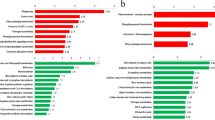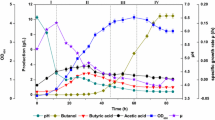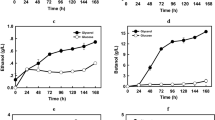Abstract
As an important feedstock monomer for the production of biodegradable stereo-complex poly-lactic acid polymer, d-lactate has attracted much attention. To improve d-lactate production by microorganisms such as Lactobacillus delbrueckii, various fermentation conditions were performed, such as the employment of anaerobic fermentation, the utilization of more suitable neutralizing agents, and exploitation of alternative nitrogen sources. The highest d-lactate titer could reach 133 g/L under the optimally combined fermentation condition, increased by 70.5% compared with the control. To decipher the potential mechanisms of d-lactate overproduction, the time-series response of intracellular metabolism to different fermentation conditions was investigated by GC–MS and LC–MS/MS-based metabolomic analysis. Then the metabolomic datasets were subjected to weighted correlation network analysis (WGCNA), and nine distinct metabolic modules and eight hub metabolites were identified to be specifically associated with d-lactate production. Moreover, a quantitative iTRAQ–LC–MS/MS proteomic approach was employed to further analyze the change of intracellular metabolism under the combined fermentation condition, identifying 97 up-regulated and 42 down-regulated proteins compared with the control. The in-depth analysis elucidated how the key factors exerted influence on d-lactate biosynthesis. The results revealed that glycolysis and pentose phosphate pathways, transport of glucose, amino acids and peptides, amino acid metabolism, peptide hydrolysis, synthesis of nucleotides and proteins, and cell division were all strengthened, while ATP consumption for exporting proton, cell damage, metabolic burden caused by stress response, and bypass of pyruvate were decreased under the combined condition. These might be the main reasons for significantly improved d-lactate production. These findings provide the first omics view of cell growth and d-lactate overproduction in L. delbrueckii, which can be a theoretical basis for further improving the production of d-lactate.






Similar content being viewed by others
References
Abdel-Banat BMA, Hoshida H, Ano A, Nonklang S, Akada R (2010) High-temperature fermentation: how can processes for ethanol production at high temperatures become superior to the traditional process using mesophilic yeast? Appl Microbiol Biotechnol 85:861–867. https://doi.org/10.1007/s00253-009-2248-5
Bai Z, Gao Z, Sun J, Wu B, He B (2016) d-Lactic acid production by Sporolactobacillus inulinus YBS1-5 with simultaneous utilization of cottonseed meal and corncob residue. Bioresour Technol 207:346–352. https://doi.org/10.1016/j.biortech.2016.02.007
Berry AR, Franco CMM, Zhang W, Middelberg APJ (1999) Growth and lactic acid production in batch culture of Lactobacillus rhamnosus in a defined medium. Biotechnol Lett 21:163–167. https://doi.org/10.1023/a:1005483609065
Christensen J, Dudley E, Pederson JA, Steele J (1999) Peptidases and amino acid catabolism in lactic acid bacteria. Antonie Van Leeuwenhoek 76(1–4):217–246. https://doi.org/10.1023/a:1002001919720
Courant F, Martzolff A, Rabin G, Antignac J-P, Le Bizec B, Giraudeau P, Tea I, Akoka S, Couzinet A, Cogne G, Grizeau D, Goncalves O (2013) How metabolomics can contribute to bio-processes: a proof of concept study for biomarkers discovery in the context of nitrogen-starved microalgae grown in photobioreactors. Metabolomics 9:1286–1300. https://doi.org/10.1007/s11306-013-0532-y
Ding M-Z, Cheng J-S, Xiao W-H, Qiao B, Yuan Y-J (2009) Comparative metabolomic analysis on industrial continuous and batch ethanol fermentation processes by GC–TOF–MS. Metabolomics 5:229–238. https://doi.org/10.1007/s11306-008-0145-z
Fernández M, Zúñiga M (2006) Amino acid catabolic pathways of lactic acid bacteria. Crit Rev Microbiol 32:155–183. https://doi.org/10.1080/10408410600880643
Fodinger M, Horl WH, Sunder-Plassmann G (2000) Molecular biology of 5,10-methylenetetrahydrofolate reductase. J Nephrol 13:20–33
Francl AL, Thongaram T, Miller MJ (2010) The PTS transporters of Lactobacillus gasseri ATCC 33323. BMC Microbiol 10:77. https://doi.org/10.1186/1471-2180-10-77
Frees D, Vogensen FK, Ingmer H (2003) Identification of proteins induced at low pH in Lactococcus lactis. Int J Food Microbiol 87:293–300. https://doi.org/10.1016/s0168-1605(03)00104-1
Fu X, Wang Y, Wang J, Garza E, Manow R, Zhou S (2017) Semi-industrial scale (30 m3) fed-batch fermentation for the production of d-lactate by Escherichia coli strain HBUT-D15. J Ind Microbiol Biotechnol 44:221–228. https://doi.org/10.1007/s10295-016-1877-9
Fukushima K, Chang Y-H, Kimura Y (2007) Enhanced stereocomplex formation of poly(l-lactic acid) and poly(d-lactic acid) in the presence of stereoblock poly(lactic acid). Macromol Biosci 7:829–835. https://doi.org/10.1002/mabi.200700028
Gan CS, Chong PK, Pham TK, Wright PC (2007) Technical, experimental, and biological variations in isobaric tags for relative and absolute quantitation (iTRAQ). J Proteome Res 6:821–827. https://doi.org/10.1021/pr060474i
Gao X, Sun T, Wu L, Chen L, Zhang W (2017) Co-overexpression of response regulator genes slr1037 and sll0039 improves tolerance of Synechocystis sp PCC 6803 to 1-butanol. Bioresour Technol 245:1476–1483. https://doi.org/10.1016/j.biortech.2017.04.112
Garlotta D (2001) A literature review of poly(lactic acid). J Polym Environ 9:63–84. https://doi.org/10.1023/a:1020200822435
Giraud E, Lelong B, Raimbault M (1991) Influence of pH and initial lactate concentration on the growth of Lactobacillus plantarum. Appl Microbiol Biotechnol 36:96–99. https://doi.org/10.1007/bf00164706
Glaasker E, Heuberger EHML, Konings WN, Poolman B (1998) Mechanism of osmotic activation of the quaternary ammonium compound transporter (QacT) of Lactobacillus plantarum. J Bacteriol 180:5540
Glaasker E, Konings WN, Poolman B (1996) Osmotic regulation of intracellular solute pools in Lactobacillus plantarum. J Bacteriol 178:575
Goehring NW, Beckwith J (2005) Diverse paths to midcell: assembly of the bacterial cell division machinery. Curr Biol 15:R514–R526. https://doi.org/10.1016/j.cub.2005.06.038
Guerzoni ME, Lanciotti R, Cocconcelli PS (2001) Alteration in cellular fatty acid composition as a response to salt, acid, oxidative and thermal stresses in Lactobacillus helveticus. Microbiology 147:2255–2264. https://doi.org/10.1099/00221287-147-8-2255
Hofvendahl K, Hahn-Hagerdal B (2000) Factors affecting the fermentative lactic acid production from renewable resources. Enzyme Microb Technol 26:87–107. https://doi.org/10.1016/s0141-0229(99)00155-6
Hua Y, Wang S, Liu Z, Liu X, Zou L, Gu W, Hou Y, Ma Y, Luo Y, Liu J (2016) iTRAQ-based quantitative proteomic analysis of cultivated Pseudostellaria heterophylla and its wild-type. J Proteom 139:13–25. https://doi.org/10.1016/j.jprot.2016.02.027
Hutkins RW, Nannen NL (1993) pH homeostasis in lactic acid bacteria. J Dairy Sci 76:2354–2365. https://doi.org/10.3168/jds.S0022-0302(93)77573-6
Klotz S, Kaufmann N, Kuenz A, Prüße U (2016) Biotechnological production of enantiomerically pure d-lactic acid. Appl Microbiol Biotechnol 100:9423–9437. https://doi.org/10.1007/s00253-016-7843-7
Klotz S, Kuenz A, Pruesse U (2017) Nutritional requirements and the impact of yeast extract on the d-lactic acid production by Sporolactobacillus inulinus. Green Chem 19:4633–4641. https://doi.org/10.1039/c7gc01796k
Koponen J, Laakso K, Koskenniemi K, Kankainen M, Savijoki K, Nyman TA, de Vos WM, Tynkkynen S, Kalkkinen N, Varmanen P (2012) Effect of acid stress on protein expression and phosphorylation in Lactobacillus rhamnosus GG. J Proteom 75:1357–1374. https://doi.org/10.1016/j.jprot.2011.11.009
Li J, Sun J, Wu B, He B (2017) Combined utilization of nutrients and sugar derived from wheat bran for d-lactate fermentation by Sporolactobacillus inulinus YBS1-5. Bioresour Technol 229:33–38. https://doi.org/10.1016/j.biortech.2016.12.101
Liu H, Huang D, Jin L, Wang C, Liang S, Wen J (2017) Integrating multi-omics analyses of Nonomuraea dietziae to reveal the role of soybean oil in [(4′-OH)MeLeu]4-CsA overproduction. Microb Cell Fact 16:120. https://doi.org/10.1186/s12934-017-0739-0
Lv L-X, Yan R, Shi H-Y, Shi D, Fang D-Q, Jiang H-Y, Wu W-R, Guo F-F, Jiang X-W, Gu S-L, Chen Y-B, Yao J, Li L-J (2017) Integrated transcriptomic and proteomic analysis of the bile stress response in probiotic Lactobacillus salivarius LI01. J Proteom 150:216–229. https://doi.org/10.1016/j.jprot.2016.08.021
Marty-Teysset C, de la Torre F, Garel JR (2000) Increased production of hydrogen peroxide by Lactobacillus delbrueckii subsp bulgaricus upon aeration: involvement of an NADH oxidase in oxidative stress. Appl Environ Microbiol 66:262–267. https://doi.org/10.1128/aem.66.1.262-267.2000
Mimitsuka T, Na K, Morita K, Sawai H, Minegishi S, Henmi M, Yamada K, Shimizu S, Yonehara T (2012) A membrane-integrated fermentation reactor system: its effects in reducing the amount of sub-raw materials for d-lactic acid continuous fermentation by Sporolactobacillus laevolacticus. Biosci Biotechnol Biochem 76:67–72. https://doi.org/10.1271/bbb.110499
Miyoshi A, Rochat T, Gratadoux J-J, Le Loir Y, Oliveira SC, Langella P, Azevedo V (2003) Oxidative stress in Lactococcus lactis. Genet Mol Res 2:348–359
Morishita T, Yajima M (1995) Incomplete operation of biosynthetic and bioenergetic functions of the citric acid cycle in multiple auxotrophic Lactobacilli. Biosci Biotechnol Biochem 59:251–255. https://doi.org/10.1271/bbb.59.251
Mura A, Fadda D, Perez AJ, Danforth ML, Musu D, Rico AI, Krupka M, Denapaite D, Tsui H-CT, Winkler ME, Branny P, Vicente M, Margolin W, Massidda O (2017) Roles of the essential protein FtsA in cell growth and division in Streptococcus pneumoniae. J Bacteriol. https://doi.org/10.1128/jb.00608-16
Nakano S, Ugwu CU, Tokiwa Y (2012) Efficient production of d-(−)-lactic acid from broken rice by Lactobacillus delbrueckii using Ca(OH)2 as a neutralizing agent. Bioresour Technol 104:791–794. https://doi.org/10.1016/j.biortech.2011.10.017
Papadimitriou K, Alegria A, Bron PA, de Angelis M, Gobbetti M, Kleerebezem M, Lemos JA, Linares DM, Ross P, Stanton C, Turroni F, van Sinderen D, Varmanen P, Ventura M, Zuniga M, Tsakalidou E, Kok J (2016) Stress physiology of lactic acid bacteria. Microbiol Mol Biol Rev 80:837–890. https://doi.org/10.1128/mmbr.00076-15
Papagianni M, Avramidis N (2011) Lactococcus lactis as a cell factory: a twofold increase in phosphofructokinase activity results in a proportional increase in specific rates of glucose uptake and lactate formation. Enzyme Microb Technol 49:197–202. https://doi.org/10.1016/j.enzmictec.2011.05.002
Papagianni M, Avramidis N, Filiousis G (2007) Glycolysis and the regulation of glucose transport in Lactococcus lactis spp. lactis in batch and fed-batch culture. Microb Cell Fact 6:16. https://doi.org/10.1186/1475-2859-6-16
Partanen L, Marttinen N, Alatossava T (2001) Fats and fatty acids as growth factors for Lactobacillus delbrueckii. Syst Appl Microbiol 24:500–506. https://doi.org/10.1078/0723-2020-00078
Pei G, Chen L, Zhang W (2017) Chapter nine-WGCNA application to proteomic and metabolomic data analysis. Methods Enzymol 585:135–158
Purvis JE, Yomano LP, Ingram LO (2005) Enhanced trehalose production improves growth of Escherichia coli under osmotic stress. Appl Environ Microbiol 71:3761–3769. https://doi.org/10.1128/aem.71.7.3761-3769.2005
Roudot-Algaron F, Yvon M (1998) Aromatic and branched chain amino acids catabolism in Lactococcus lactis. Lait 78:23–30
Savijoki K, Ingmer H, Varmanen P (2006) Proteolytic systems of lactic acid bacteria. Appl Microbiol Biotechnol 71:394–406
Serrazanetti DI, Ndagijimana M, Sado-Kamdem SL, Corsetti A, Vogel RF, Ehrmann M, Guerzoni ME (2011) Acid stress-mediated metabolic shift in Lactobacillus sanfranciscensis LSCE1. Appl Environ Microbiol 77:2656–2666. https://doi.org/10.1128/AEM.01826-10
Su Y, Wang J, Shi M, Niu X, Yu X, Gao L, Zhang X, Chen L, Zhang W (2014) Metabolomic and network analysis of astaxanthin-producing Haematococcus pluvialis under various stress conditions. Bioresour Technol 170:522–529. https://doi.org/10.1016/j.biortech.2014.08.018
Sun J, Wang Y, Wu B, Bai Z, He B (2015) Enhanced production of d-lactic acid by Sporolactobacillus sp Y2-8 mutant generated by atmospheric and room temperature plasma. Biotechnol Appl Biochem 62:287–292. https://doi.org/10.1002/bab.1267
Tokiwa Y, Calabia BP (2006) Biodegradability and biodegradation of poly(lactide). Appl Microbiol Biotechnol 72:244–251. https://doi.org/10.1007/s00253-006-0488-1
Turgay K (2011) Role of proteolysis and chaperones in stress response and regulation. Bacterial stress responses, 2nd edn. American Society of Microbiology, Washington, DC, pp 75–90
van de Guchte M, Penaud S, Grimaldi C, Barbe V, Bryson K, Nicolas P, Robert C, Oztas S, Mangenot S, Couloux A, Loux V, Dervyn R, Bossy R, Bolotin A, Batto JM, Walunas T, Gibrat JF, Bessieres P, Weissenbach J, Ehrlich SD, Maguin E (2006) The complete genome sequence of Lactobacillus bulgaricus reveals extensive and ongoing reductive evolution. Proc Natl Acad Sci USA 103:9274–9279. https://doi.org/10.1073/pnas.0603024103
van de Guchte M, Serror P, Chervaux C, Smokvina T, Ehrlich SD, Maguin E (2002) Stress responses in lactic acid bacteria. Antonie Van Leeuwenhoek Int J Gen Mol Microbiol 82:187–216. https://doi.org/10.1023/a:1020631532202
Wang C, Liu J, Liu H, Liang S, Wen J (2017) Combining metabolomics and network analysis to improve tacrolimus production in Streptomyces tsukubaensis using different exogenous feedings. J Ind Microbiol Biotechnol 44:1527–1540. https://doi.org/10.1007/s10295-017-1974-4
Wang G, Huang D, Qi H, Wen J, Jia X, Chen Y (2013) Rational medium optimization based on comparative metabolic profiling analysis to improve fumaric acid production. Bioresour Technol 137:1–8. https://doi.org/10.1016/j.biortech.2013.03.041
Wang J, Hui W, Cao C, Jin R, Ren C, Zhang H, Zhang W (2016) Proteomic analysis of an engineered isolate of Lactobacillus plantarum with enhanced raffinose metabolic capacity. Sci Rep 6:31403. https://doi.org/10.1038/srep31403
Wang L, Zhao B, Li F, Xu K, Ma C, Tao F, Li Q, Xu P (2011) Highly efficient production of d-lactate by Sporolactobacillus sp. CASD with simultaneous enzymatic hydrolysis of peanut meal. Appl Microbiol Biotechnol 89:1009–1017. https://doi.org/10.1007/s00253-010-2904-9
Xia M, Huang D, Li S, Wen J, Jia X, Chen Y (2013) Enhanced FK506 production in Streptomyces tsukubaensis by rational feeding strategies based on comparative metabolic profiling analysis. Biotechnol Bioeng 110:2717–2730. https://doi.org/10.1002/bit.24941
Yu X, Niu X, Zhang X, Pei G, Liu J, Chen L, Zhang W (2015) Identification and mechanism analysis of chemical modulators enhancing astaxanthin accumulation in Haematococcus pluvialis. Algal Res 11:284–293. https://doi.org/10.1016/j.algal.2015.07.006
Zhai Z, Douillard FP, An H, Wang G, Guo X, Luo Y, Hao Y (2014) Proteomic characterization of the acid tolerance response in Lactobacillus delbrueckii subsp bulgaricus CAUH1 and functional identification of a novel acid stress-related transcriptional regulator Ldb0677. Environ Microbiol 16:1524–1537. https://doi.org/10.1111/1462-2920.12280
Zhang B, Horvath S (2005) A general framework for weighted gene co-expression network analysis. Stat Appl Genet Mol Biol 4:Article 17
Zhao J, Baba T, Mori H, Shimizu K (2004) Effect of zwf gene knockout on the metabolism of Escherichia coli grown on glucose or acetate. Metab Eng 6:164–174. https://doi.org/10.1016/j.ymben.2004.02.004
Acknowledgements
This work was financially supported by the National Natural Science Foundation of China (no. 21676189); and the key technologies R & D program of Tianjin (no. 16YFZCSY00780).
Author information
Authors and Affiliations
Corresponding author
Electronic supplementary material
Below is the link to the electronic supplementary material.
Rights and permissions
About this article
Cite this article
Liang, S., Gao, D., Liu, H. et al. Metabolomic and proteomic analysis of d-lactate-producing Lactobacillus delbrueckii under various fermentation conditions. J Ind Microbiol Biotechnol 45, 681–696 (2018). https://doi.org/10.1007/s10295-018-2048-y
Received:
Accepted:
Published:
Issue Date:
DOI: https://doi.org/10.1007/s10295-018-2048-y




